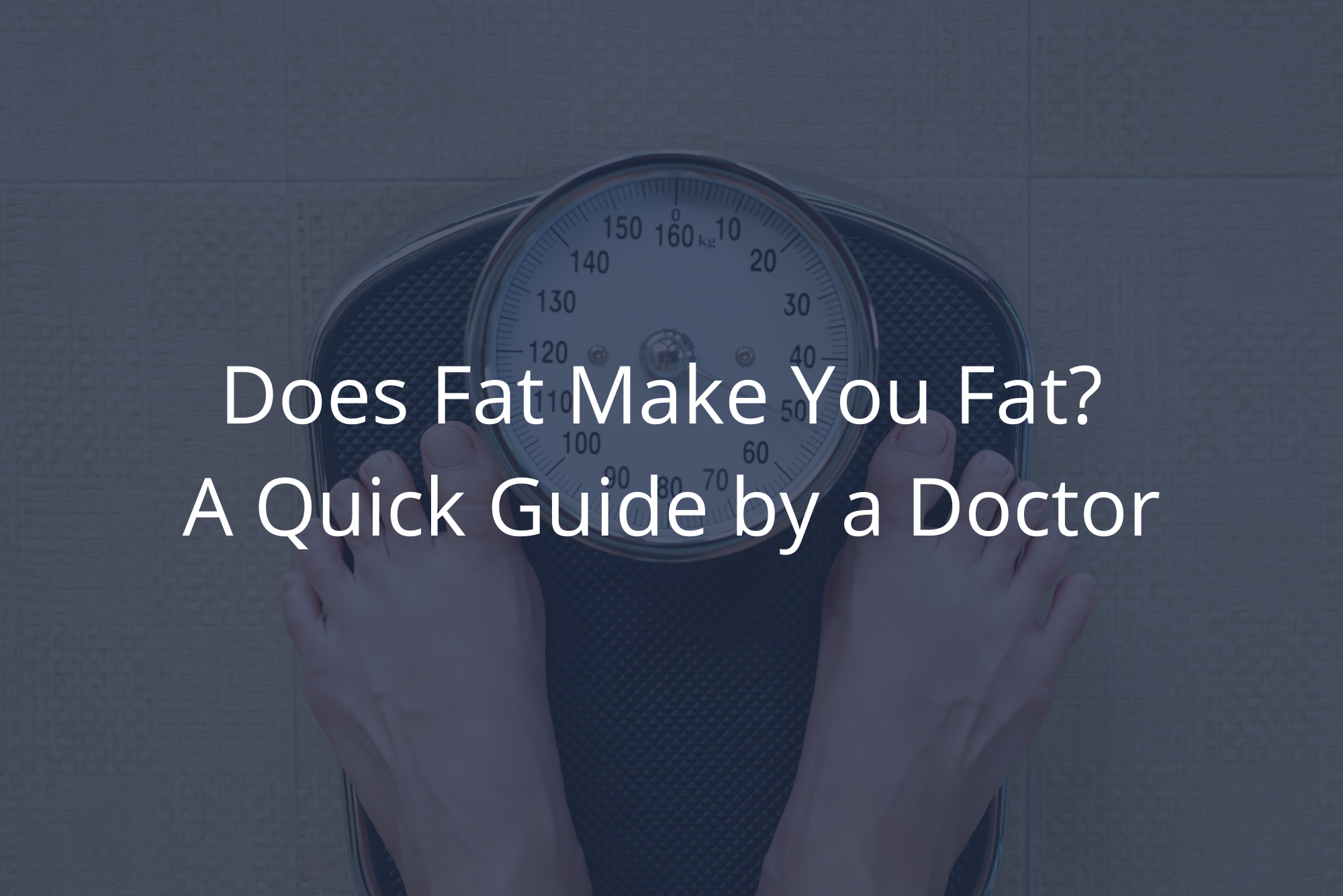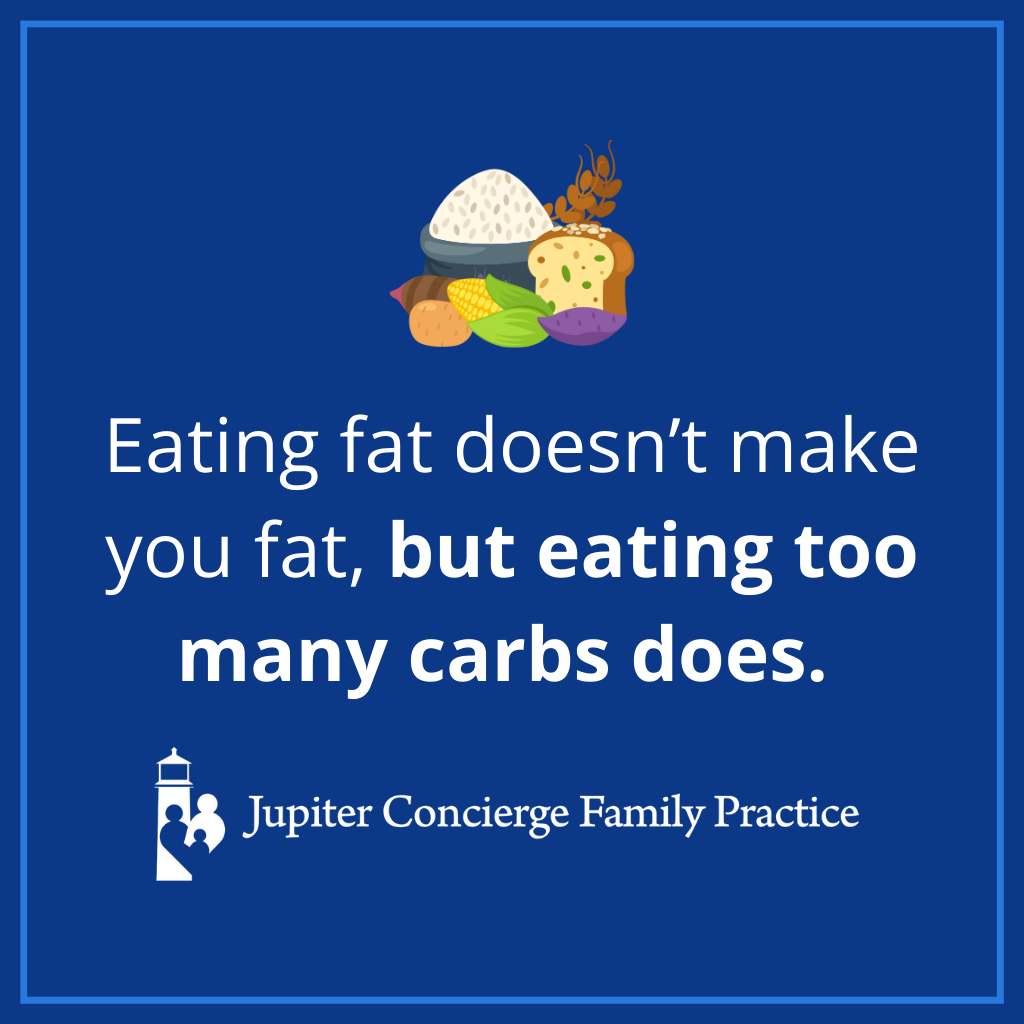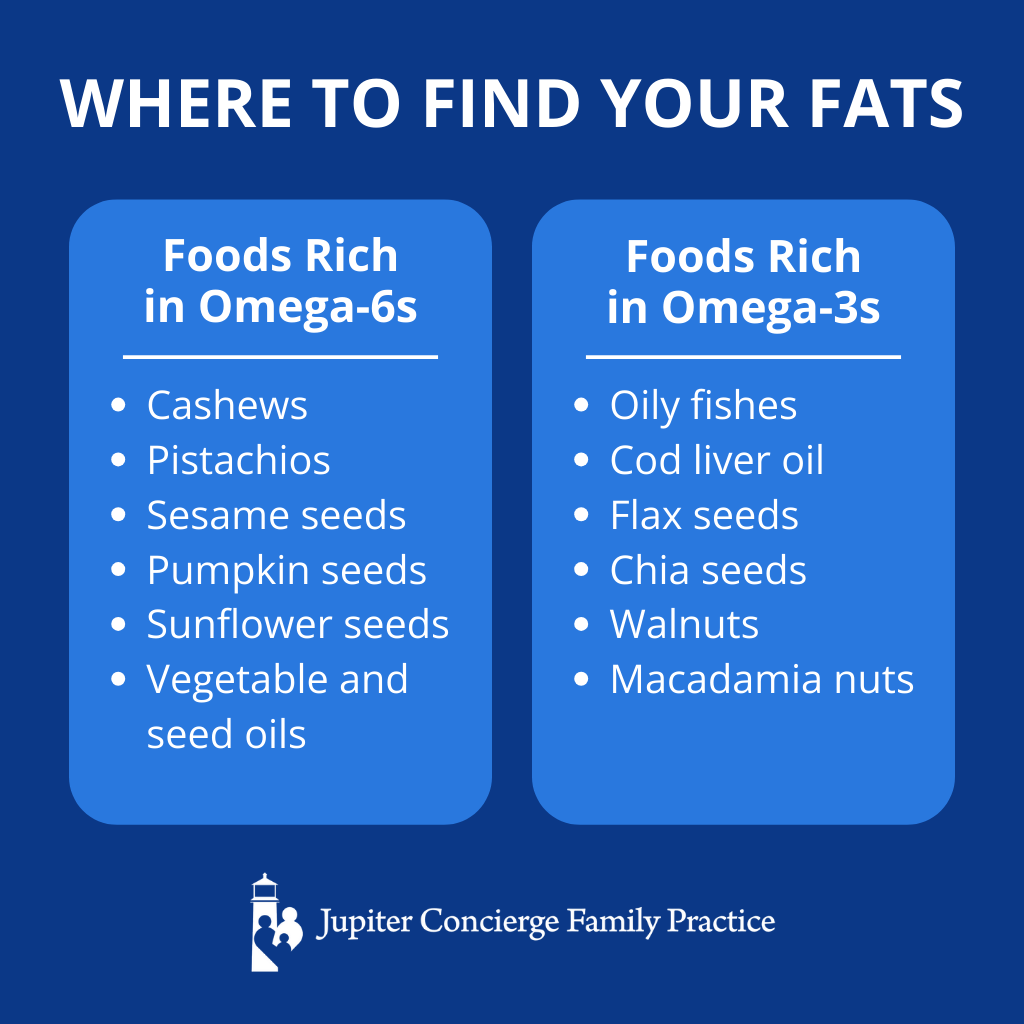
Fats have long gotten a bad rap. And it makes some sense: People, even many scientists, equate fat in foods with fat on your body.
But is fat’s poor reputation deserved? Are low-fat foods the better choice for health? Does fat really make you fat?
In a world where “low fat” is an oft-used and highly effective selling point for food products, we need to examine the science. Let’s dive into the facts about fats.
Does Fat Make You Fat? 3 Macronutrients for Health
There are only three types of macronutrients to nourish our bodies: carbohydrates, proteins, and fats.
When companies plaster “low fat” across a food product’s packaging, they intend for shoppers to assume the item is healthy. But if a food has low or no fat, it must be made up of the other two macronutrients: protein and/or carbs.
Carbohydrates are far cheaper (and tastier) than protein, so most low-fat foods typically deliver far more carbs than anything else. The problem? Carbohydrates break down into glucose (sugar) in your body, and excess sugar creates — you guessed it — fat.
Herein lies the real culprit of so much weight gain. Eating fat doesn’t make you fat, but eating too many carbs does because sugar produces fat in the body.
Why Your Body Needs Fat
Beyond the question of does fat make you fat lurks another important consideration: Is fat good for you?
The truth is, you need all three macronutrients for proper nutrition (yes, even carbs — but that’s a topic for another post). Healthy versions and proportions of macronutrients provide the balanced nutrient intake your body needs for optimal health.
One of the most important functions fats serve is providing the infrastructure for cell membranes. If you’re short of healthy fats, such as omega-3 and omega-6 fats, your body can’t maintain its cell membranes, and your physiology suffers.
You can think of your cell membranes like the skin on your body. Your skin protects you, keeping the good stuff in and the bad stuff out, and it interacts with the world around you. Now imagine you get a third-degree burn on 10% of your body. In such a case, you’d end up in the ICU in terrible pain, losing important bodily fluids and vulnerable to pathogens.
Well, a cell membrane is similarly important to a cell’s “body,” and a lack of proper fat nutrients compromises their ability to function.
The Balancing Act of Omega-3s and 6s
Omega-3 and omega-6 fatty acids are the two most common types of fats. Long ago in human history, our hunter-gatherer forebears got these essential nutrients in a balanced 1:1 ratio.
Omegas are all about balance. Nowadays, a 1:1 ratio is fairly untenable, but we still consider a healthy ratio to be about 4:1 omega-6s to omega-3s.
The problem? Most of our modern diets provide a ratio of 20:1, 30:1, or higher, a ratio that’s distinctly unhealthy.
This phenomenon has led many to consider omega-6s — mainly from vegetable oils — as unhealthy in and of themselves. But this isn’t the case. As long as they’re matched with a proper ratio of omega-3s, omega-6s aren’t bad for you; in fact, they’re a necessary nutrient.
Where to Find Your Fats
So how can you get these healthy fats in your diet? Get ready for lots of nuts, seeds, and fish.
Foods Rich in Omega-6s:
- Cashews
- Pistachios
- Sesame seeds
- Pumpkin seeds
- Sunflower seeds
- Certain seed and vegetable oils (safflower, sunflower, canola, corn, soybean)
Foods Rich in Omega-3s:
- Oily fishes (salmon, sardines, anchovies, mackerel, herring)
- Cod liver oil
- Flax seeds
- Chia seeds
- Walnuts
- Macadamia nuts
While these lists aren’t exhaustive, they’re an excellent place to start. Remember to incorporate a variety of selections in your diet to achieve a good balance.
A note on omega-3s: Fish are by far the easiest and richest source of omega-3 fatty acids, so it’s worthwhile to try incorporating seafood into your diet if you haven’t in the past.
When looking for omega-3-rich fish, opt for wild-caught selections, like wild-caught Alaskan salmon. And remember: The oilier the fish, the higher its beneficial fat content.
When Good Fats Go Bad: The Problem With Processed Fats
While just about all naturally occurring fats have health benefits, processed fats can be downright toxic.
But isn’t it the same food, even after processing? Well, yes and no.
In their natural state, fats oxidize — or “go bad” — rather quickly, prompting food manufacturers to introduce the process of… well, processing. This intensive ordeal changes a fat’s molecular structure to achieve a longer shelf life.
While processing means far less spoiled food in grocery aisles and pantries, it also means natural fats lose their nutritional value and gain a chemical structure that’s foreign to our bodies. And, unfortunately, these now-foreign substances can cause digestive issues, trigger immune reactions, and even act as carcinogens.
Home Cooking: Beat the Heat
Heat is the worst offender in altering the nutritional value and molecular structure of fats. And its effects aren’t limited to large-scale processing operations.
Even at home, the heat from your oven or stove can produce a “processing” effect on fats. Take extra virgin olive oil, for example. It’s one of the healthiest fat sources you can consume — until heated too high. At that point, the molecular structure changes, harmful compounds are produced, and the oil becomes unhealthy.
To preserve the beneficial properties of healthy fats, we generally recommend keeping cooking temperatures around 350°F or lower.
Healthy or Harmful: Quick Tips on Common Fats
Below are a few examples of healthier fat choices compared to their more processed alternatives:
Grass-Fed Butter vs. Margarine
If you’re choosing between butter and margarine, go for grass-fed butter every time. Margarine is one of the most harmful fats out there due to its heavy processing. It offers no nutritional value and can even be toxic.
On the other hand, butter — especially from grass-fed cows — has some beneficial qualities. Yes, it’s high in calories; it is a fat, after all. But it contains health-promoting compounds, like carotenoids, without the harmful properties of margarine. Just remember to consume it in moderation.
Olive Oil vs. Refined Vegetable Oils
Most commercial vegetable oils like canola, safflower, and sunflower oils are highly processed. While they do contain omega-6 fatty acids, the intense processing destroys potential health benefits. Plus, these oils are often used for high-heat cooking, which further degrades their quality.
Minimally processed cooking oils deliver all the health benefits and none of the pitfalls of heavily processed oils. The most common type is, of course, extra virgin olive oil, which is rich in healthy monounsaturated fats and antioxidants.
Again, if cooking with olive oil, keep those cooking temperatures at or below 350°F to avoid damaging its delicate compounds. And if possible, look for minimally processed versions of other plant oils — just be prepared to pay a bit more.
Raw or Lightly Salted Nuts vs. Roasted and Flavored
Nuts are a fantastic source of healthy fats, fiber, and plant protein. But the way they’re prepared can make a big difference in their nutritional value.
The healthiest options are raw or unshelled nuts. Lightly salted nuts are okay, too. What you want to avoid are heavily roasted, salted, or sweetened nuts. The high temperatures used in roasting can damage nuts’ healthy fats, while added sugars and excess salt can negate their nutritional health benefits.
I get it — those honey roasted peanuts are hard to resist! But if you’re snacking on nuts for health, stick with the most natural options. Your body will appreciate the unadulterated goodness.
Plant-Based vs. Animal Fats
Many people have questions about plant-based vs. animal fats, so we’ll touch briefly on the difference here.
Nutritionally, we categorize fats as either saturated or unsaturated, which has to do with their chemical structure. Both are important for a balanced diet.
As a general principle, animal fats tend to be saturated fats, and vegetable fats tend to be unsaturated (or polyunsaturated) fats. One key difference is that saturated fats oxidize more easily, making them more likely to stimulate cholesterol buildup in the arteries. Polyunsaturated fats don’t have that same property.
Healthy Fat Swaps
If you’d like to use healthier, less processed fats in your diet, one easy path is doing a simple Google search for “healthy fat substitutions” and recipe ideas. Common suggestions include:
- Taking advantage of avocado’s creamy texture as a substitute for mayonnaise in certain recipes
- Grinding nuts in a food processor to use as the creamy component in certain sauces
Many times, you won’t even notice a difference when substituting healthy, minimally processed fats into your recipes. Other times, they add a delightful flavor. Get creative in the kitchen and see how easy (and delicious) it can be to use healthy fats.
Does Fat Make You Fat? The Bottom Line
Fat itself isn’t the enemy. Processed foods high in refined carbs and molecularly altered fats are more likely to cause weight gain and health issues than whole food sources of healthy fats. And remember, “low fat” doesn’t equal “healthy” — but it often means “high carb.”
So go ahead, enjoy some salmon and a little avocado. Your cells will be happy you did.

Dr. David Rosenberg
Dr. Rosenberg is a board-certified Family Physician. He received his medical degree from the University of Miami in 1988 and completed his residency in Family Medicine at The Washington Hospital in Washington, Pennsylvania in 1991. After practicing Emergency Medicine at Palm Beach Gardens Medical Center for two years, he started private practice in Jupiter, in 1993. He is an avid baseball fan and Beatles fanatic, since he was 8 years old. He has been married to his wife, Mary, since 1985 and has three grown children.
David completed additional studies at Mercer University, Macon, Georgia and obtained a BS in Chemistry in 1983.
“My interests include tennis, snow skiing, Pilates and self-development.”


